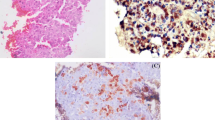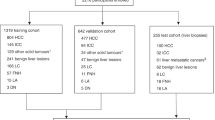Abstract
Background
Early detection of small HCC and differentiation between HCC from AC metastatic to the liver is very essential for surgical pathologists, due to different treatment modalities. Immunohistochemistry plays a very important role in such conditions.
In our study, we aimed to identify the diagnostic benefits of Arginase-1, FTCD& MOC-31 in the early detection of HCC in normal or cirrhotic liver, differentiation between HCC and metastatic ACs to the liver, and for early detection of small micro-metastases from ACs to liver.
Materials and Methods
We included 20 samples from liver cirrhosis, 10 samples from normal liver tissue, 30 samples from primary HCCs in the liver, and 30 samples from metastatic ACs to the liver. We have evaluated Arginase-1, FTCD, and MOC-31 expression using immunohistochemistry.
Results
The sensitivity of Arginase-1 expression in differentiation between HCC and metastatic carcinoma was 93.3% and the specificity was 93.3%.
The sensitivity of FTCD expression in differentiation between HCC and normal or cirrhotic liver and early detection of well-differentiated HCC was 90% and the specificity was 86.7%. The sensitivity of MOC-31 expression in differentiation between HCC and metastatic carcinoma was 90% and the specificity was 90%. The sensitivity of combination of panel of Arginase 1 + FTCD + MOC 31 expression in differentiation between HCC, metastatic carcinoma, and normal and cirrhotic liver was 93.3% and the specificity was 93.3%.
Conclusions
The combination of Arginase 1 + FTCD + MOC 31 expression was helpful in diagnosing most cases of HCC and metastatic carcinoma with high sensitivity and specificity.



Similar content being viewed by others
References
Ferlay J1, Soerjomataram I, Dikshit R, Eser S, Mathers C, Rebelo M, Parkin DM, Forman D, Bray F. Cancer incidence and mortality worldwide: sources, methods and major patterns in GLOBOCAN 2012. Int J Cancer 2015; 136: 359.
El-Serag HB, Kanwal F. Epidemiology of hepatocellular carcinoma in the United States: where are we? Where do we go? Hepatology. 2014;60:1767–75.
Sang W, Zhang W, Cui W, Li X, Abulajiang G, Li Q. Arginase-1 is a more sensitive marker than HepPar-1 and AFP in differential diagnosis of hepatocellular carcinoma from nonhepatocellular carcinoma. Tumor Biol. 2015;36(5):3881–6.
Knudsen ES, Gopal P, Singal AG. The changing landscape of hepatocellular carcinoma: etiology, genetics, and therapy. Am J Pathol. 2014;184(3):574–83.
Seimiya M, Tomonaga T, Matsushita K, Sunaga M, Oh-ishi M, Kodera Y, et al. Identification of novel immunohistochemical tumor markers for primary hepatocellular carcinoma; clathrin heavy chain and formiminotransferase cyclodeaminase. HEPATOLOGY. 2008;48:2.
Jenkinson CP, Grody WW, Cederbaum SD. Comparative properties of arginases. Comp Biochem Physiol B Biochem Mol Biol. 1996;114:107–32.
Morris SM Jr. Recent advances in arginine metabolism: roles and regulation of the arginases. Br J Pharmacol. 2009;157:922–30.
Munder M. Arginase: an emerging key player in the mammalian immune system. Br J Pharmacol. 2009;158:638–51.
Murley LL, MacKenzie RE. The two monofunctional domains of octameric formiminotransferase–cyclodeaminase exist as dimers. Biochemistry. 1995;34:10358–64.
Hagiwara H, Tajika Y, Matsuzaki T, Suzuki T, Aoki T, Takata K. Localization of Golgi 58K protein (formiminotransferase cyclodeaminase) to the centrosome. Histochem Cell Biol. 2006;126:251–9. https://doi.org/10.1007/s00418-006-0166-5.
Bashour AM, Bloom GS. 58K, a microtubule-binding Golgi protein, is a formiminotransferase cyclodeaminase. J Biol Chem. 1998;273:19612–7.
Solans A, Estivill X, de La Luna S. Cloning and characterization of human FTCD on 21q22.3, a candidate gene for glutamate formiminotransferase deficiency. Cytogenet Cell Genet. 2002;88:43–9.
Sawan A. The diagnostic value of immunohistochemistry in the diagnosis of primary and secondary hepatic carcinomas. J King Abdulaziz Univ Med Sci. 2009;16:37–48.
Radwan NA, Ahmed NS. The diagnostic value of arginase-1 immunostaining in differentiating hepatocellular carcinoma from metastatic carcinoma and cholangiocarcinoma as compared to HepPar-1. Diagn Pathol. 2012;7:149.
Fong D, Seeber A, Terracciano L, Kasal A, Mazzoleni G, Lehne F, et al. Expression of EpCAMMF and EpCAMMT variants in human carcinomas. J Clin Pathol. 2014;67:408–14.
Manuel Schlageter, Luigi Maria Terracciano, Salvatore D’Angelo, and Paolo Sorrentino Histopathology of hepatocellular carcinomaWorld J Gastroenterol 2014; 20(43): 15955–15964.
Hsu SM, Raine L, Fanger H. Use of avidin-biotin-peroxidase complex (ABC) in immunoperoxidase techniques: a comparison between ABC and unlabeled antibody (PAP) procedures. J Histochem Cytochem. 1981;29:577–80.
Geramizadeh B, Seirfar N. Diagnostic value of arginase-1 and glypican-3 in differential diagnosis of hepatocellular carcinoma, cholangiocarcinoma and metastatic carcinoma of liver. Hepat Mon. 2015;15(7):e30336.
Karabork A, Kaygusuz G, Ekinci C. The best immunohistochemical panel for differentiating hepatocellular carcinoma from metastatic adenocarcinoma. Pathol Res Pract. 2010;206:572–7.
Ordo’n˜ez N.G Arginase-1 is a novel immunohistochemical marker of hepatocellular differentiation. Adv Anat Pathol 2014; 21:285–290.
Nguyen T, Phillips D, Jain D, Torbenson M, Wu TT, Yeh MM T, Kakar S1.., Comparison of 5 immunohistochemical markers of hepatocellular differentiation for the diagnosis of hepatocellular carcinoma. Arch Pathol Lab Med 2015; 139, 1028, 1034.
Yan BC, Gong C, Song J, Krausz T, Tretiakova M, Hyjek E, et al. Arginase-1: a new immunohistochemical marker of hepatocytes and hepatocellular neoplasms. Am J Surg Pathol. 2010;34(8):1147–54.
Yan B, Wei JJ, Qian YM, Zhao XL, Zhang WW, Xu AM, et al. Expres¬sion and clinicopathologic significance of glypican 3 in hepato¬cellular carcinoma. Ann Diagn Pathol. 2011;15(3):162–9.
Krings G, Ramachandran R, Jain D, Wu TT, Yeh MM, Torbenson M, et al. Immunohistochemical pitfalls and the importance of glypican 3 and arginase in the diagnosis of scirrhous hepatocellular carcinoma. Mod Pathol. 2013;26(6):782–91.
Ramachandran R, Kakar S. Metastatic tumors: llustration of immunohistochemical workup. In: Ferrell L, Kakar S, editors. Liver pathology. New York, NY: Demos Medical Publishing; 2011. p. 431–5.
Fujiwara M, Kwok S, Yano H, Pai RK. Arginase-1 is a more sensitive marker of hepatic differentiation than HepPar-1 and glypican-3 in fine-needle aspiration biopsies. Cancer Cytopathol. 2012;120(4):230–7.
McKnight R, Nassar A, Cohen C, Siddiqui MT. Arginase-1: a novel immunohistochemical marker of hepatocellular differentiation in fine needle aspiration cytology. Cancer Cytopathol. 2012;120(4):223–9.
Timek DT, Shi J, Liu H, Lin F. Arginase-1, HepPar-1, and Glypican-3 are the most effective panel of markers in distinguishing hepatocellular carcinoma from metastatic tumor on fine-needle aspiration specimens. Am J Clin Pathol. 2012;138(2):203–10.
Hanif R, Mansoor S. Hep Par-1: a novel immunohistochemical marker for differentiating hepatocellular carcinoma from metastatic carcinoma. J Coll Physicians Surg Pak. 2014;24:186–9.
Iida H, Hata M, Kakuno A, Hirano H, Yamanegi K, Yamada N, et al. Expression of hepatocyte markers in mass-forming peripheral and periductal-infiltrating hilar intrahepatic cholangiocarcinomas. Oncol Lett. 2011;2(6):1041–6.
Ahmed MA, Badary FA, Yassin EH, Mohammed SA, El-Attar MM. Differential expression of MOC-31, Hep Par 1, and N-cadherin in primary carcinoma and metastatic adenocarcinoma in the liver. J Curr Med Res Pract. 2016;1:54–60.
Chen ZE. Application of immunohistochemistry in gastrointestinal and liver neoplasms. Arch Pathol Lab Med. 2015;139:14–23.
Wang L, Vuolo M, Suhrland M, Schlesinger K. HepPar1, MOC-31, pCEA, mCEA and CD10 for distinguishing hepatocellular carcinoma vs. metastatic adenocarcinoma in liver fine needle aspirates. Acta Cytol. 2006;50:257–62.
Al-Muhannadi N, Ansari N, Brahmi U, Abdel Satir A. Differential diagnosis of malignant epithelial tumours in the liver: an immunohistochemical study on liver biopsy material. Ann Hepatol. 2011;10:508–15.
Author information
Authors and Affiliations
Corresponding author
Ethics declarations
Conflict of Interest
The authors declare that they have no conflicts of interest.
Additional information
Publisher’s Note
Springer Nature remains neutral with regard to jurisdictional claims in published maps and institutional affiliations.
Rights and permissions
About this article
Cite this article
Labib, O.H., Harb, O.A., Khalil, O.H. et al. The Diagnostic Value of Arginase-1, FTCD, and MOC-31 Expression in Early Detection of Hepatocellular Carcinoma (HCC) and in Differentiation Between HCC and Metastatic Adenocarcinoma to the Liver. J Gastrointest Canc 51, 88–101 (2020). https://doi.org/10.1007/s12029-019-00211-2
Published:
Issue Date:
DOI: https://doi.org/10.1007/s12029-019-00211-2




